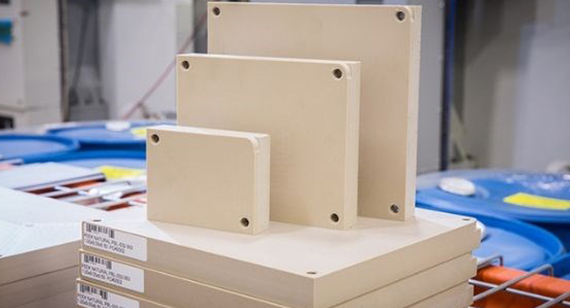CNC Machining for PEEK Parts
PEEK parts are high-temperature engineering thermoplastics that maintain excellent flexural, impact, and tensile characteristics
Get A QuoteUsing PEEK materials (chemically known as polyetheretherketone) is ideal for a wide spectrum of CNC machining applications where thermal, chemical, and combustion properties are critical to performance.
Whether in a sheet, rod, tube, or film, PEEK is a high-performance material that can be cut to size and used for a variety of CNC machining projects.

PEEK Material Properties
| Tensile Strength | Impact Strength | Tensile Modulus | Flammability | Heat Deflection Temperature |
|
|---|---|---|---|---|---|
| PEEK | 100 MPa | 4 kJ/m² (notched) | 3,600 MPa | V-O | 152 °C |
Benefits of PEEK Machining
The primary benefit of PEEK is its ability to retain its flexural and tensile properties at extremely high temperatures. It maintains those required properties when exposed to temperatures in excess of 250 degrees C. When glass fibre or carbon fibre reinforcements are added, they significantly enhances the mechanical and thermal properties of PEEK.
- Outstanding flexural, tensile, and impact characteristics
- Substantial continuous working temperature
- High continuous working temperature
- High heat distortion temperature
- Strong chemical resistance
- Superior dielectric at high temperatures and frequencies
- Exceptional radiation resistance
- Excellent wear and abrasion resistance
- Low emissions of smoke and toxic gas
- Strong hydrolysis resistance

PEEK Machining for Industrial Applications
Due to PEEK’s exceptional properties, it is used in many critical areas throughout the general industry. PEEK materials are featured prominently within automotive, medical, electronics, marine, nuclear, construction, transportation, sign and lighting, mining, manufacturing, pharmaceutical, earth moving equipment, energy and power, and aerospace fields.
PEEK materials have proven to be a highly popular plastics material throughout the industrial world, due to its proven resistance to wear, heat, and radiation, as well as its low levels of flammability, and low smoke and toxic gas emissions.
Example parts include:
- Bearings
- Thrust washers and seals
- Piston parts
- Semiconductor fabrication
- Pumps
- Compressor plate valves
- Cable insulation
- Ultra-high vacuum applications





